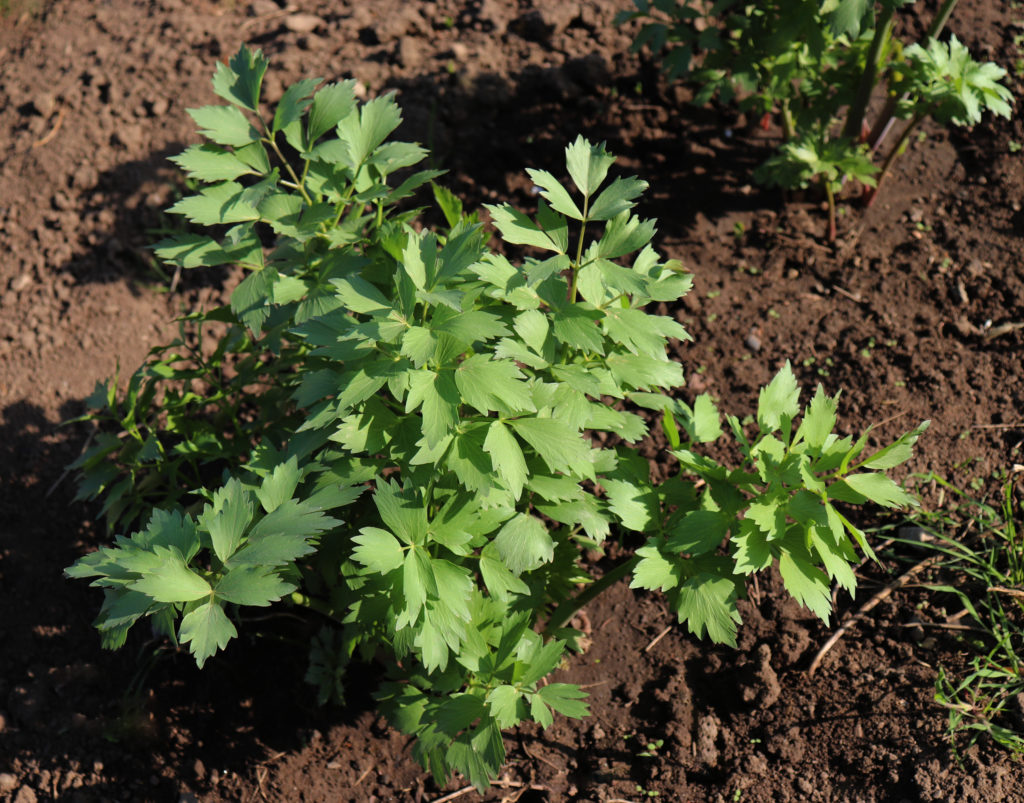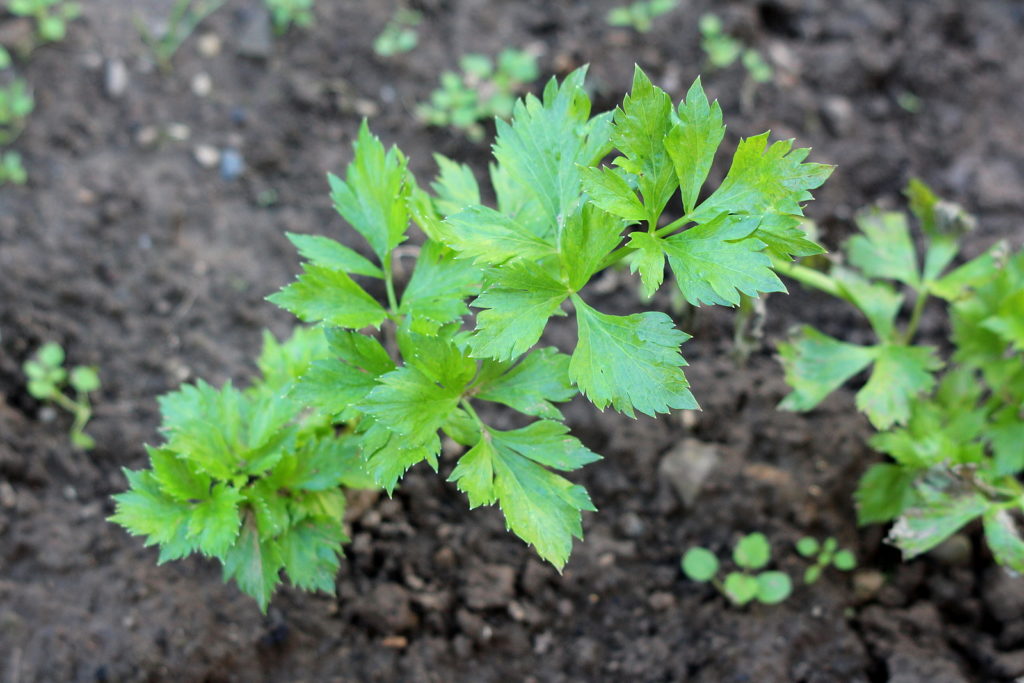Lovage is an easy-to-grow perennial herb. The leaves and seeds of lovage have a rich celery-like flavor and fragrance. Use the leaves fresh or dry in salads, soups, and stews. The hollow stems can be used as a substitute for celery in soups. Crushed seeds can be used as celery powder.
Here is your complete guide to growing lovage.
Where to plant lovage
- Best location: Lovage prefers partial or filtered shade; it will survive without direct sun as long as it receives good light. Lovage will grow in direct sun in cool summer regions.
- Soil preparation: Plant lovage in well-drained moist soil; add aged compost or commercial organic planting mix to the soil in advance of planting. Lovage prefers a soil pH of 6.0 to 7.0.
Articles of interest:
- How to Grow Herbs
- How to Start an Herb Garden
- Best Herbs for Container Growing
- Herbs for Cool Season Growing
- Grow 20 Herbs for Cooking

When to plant lovage
- Seed starting indoors: Start lovage seeds indoors in early spring in individual pots under fluorescent lights. Germination can be erratic if the seed is not fresh; fresh seed harvested in the fall and immediately planted is optimal. Germination takes 10 to 14 days. In cold winter regions, sow indoors in autumn and transplant out in spring.
- Transplanting to the garden: Set lovage seedlings in the garden when all danger of frost is past and nighttime temperatures are at least 40° Lovage has a taproot so transplant seedlings into the garden before the taproots are well established.
- Outdoor planting time: Sow lovage seed outdoors in early spring as soon as the soil can be worked or sow seed in autumn for germination the following spring.
How to plant lovage
- Planting depth: Sow seeds outdoors ½ inch deep.
- Spacing: Space plants 18 to 24 inches apart; lovage grows in clumps.
- How much to plant: Grow one lovage plant for culinary use; grow one plant for preserving.
Companion planting lovage
- Companion planting: Plant lovage with fennel, hyssop, and catmint. Lovage can be used as a trap crop to lure tomato hornworms away from tomatoes. The greenish-yellow flowers attract beneficial insects to the garden.
Watering and feeding lovage
- Watering: Keep the soil evenly moist.
- Feeding: Give plants compost tea or dilute fish emulsion a few times during the growing season. Replenish the soil each spring by adding aged compost or a commercial organic planting mix.
Lovage care and maintenance
- Care: Clip off lovage flowers to encourage bushy growth and continuous leaf production.
- Mulching: Mulch lovage with ½ inch of compost in spring. Lovage dies back in winter; protect the roots with mulch.
Container growing lovage
- Container growing: Grow lovage in a pot 12 inches wide and deep.
- Winter growing: Lovage will die back in winter. Containers can be brought indoors in winter for winter harvest. Place pots in a bright spot.
Lovage pests and diseases
- Pests: Lovage can be attacked by leafminers (small maggots) which tunnel inside leaves. The tunnels zig-zag just below the leaf surface. In most cases, only a few leaves will be affected and the plant won’t be harmed. Pick off and destroy all affected leaves (this will dispose of the maggots).
- Diseases: Lovage is rarely bothered by diseases.
How to harvest lovage
- Leaves and stalks: Snip or pinch off outside stalks and leaves as needed for fresh use anytime during the growing season. Young and tender leaves are best. For best quality, gather stalks and leaves in the morning after the dew has dried. Harvest leaves for drying before the plant flowers.
- Roots: Harvest two or three-year-old lovage roots with a garden fork just before flowering. Wash and slice roots into ½ inch pieces before drying for storage.
- Seeds: Harvest entire ripe seeds heads in late summer. Ripe lovage seeds turn tan than brown. Place seed heads in a paper bag; they will drop as they ripen or gently rub off the seeds between your palms.
Lovage in the kitchen
- Flavor and aroma: Lovage leaves, stems, and seeds have a strong celery-like flavor.
- Leaves: Use celery-flavored lovage leaves, fresh, frozen, or dried, anywhere you would use celery. Lovage enhances the flavor of potatoes, tomatoes, steamed vegetables, rice, chicken, and poultry stuffings. Use lovage leaves in soups, stews, and roasts.
- Stems: Blanch the stems and eat them like celery or slice them into salads, stews, and soups.
- Seeds: Use crushed lovage seeds as you would celery powder to season bread, soups, roasts, and cheese dishes. Seeds whole or ground can be used in pickling brines, cheese spreads, salads, salad dressing, and sauces. Use whole dry seeds in baking.
- Roots: Cook lovage roots as a side dish.

Preserving and storing lovage
- Refrigeration: Store fresh lovage leaves and stems in a plastic bag in the crisper; lovage leaves are best used right after harvest.
- Drying: Cut 1- to 3-foot sections of stem for drying. Dry leaves and stems by hanging them upside down in a warm, shady place. Lovage loses flavor unless it dries quickly. Leaves can also be dried in a warm oven or a dehydrator.
- Freezing: Blanch lovage leaves before freezing in ice cubes or oil.
- Storing: Store lovage leaves and stems in an air-tight opaque container; the light will quickly yellow leaves and stems.
Lovage propagation
- Seed: Stratify lovage seeds for 1 to 2 weeks and then sow indoors. Place them in the refrigerator. Seeds will germinate in about 14 days.
- Division: Divide mature plants in spring to early summer and in late fall.
Get to know lovage
- Botanical name and family: Levisticum officinale; lovage is a member of the Apiaceae—celery family)
- Origin: Europe and southwestern Asia near the Mediterranean
- Type of plant: Lovage is an herbaceous perennial.
- Growing season: Summer
- Growing zones: Lovage grows best in zones 4 to 8; it is hardy to zone 3.
- Hardiness: Lovage tolerates cold; it is cold hardy to -5°F; it is less tolerant of heat.
- Plant form and size: Lovage grows 3 to 4 feet tall and 18 wide. Lovage looks like an overgrown celery plant. Grows lovage in mounded clumps; stems rise above the foliage and are topped with sprays of greenish-yellow flower umbels.
- Flowers: Lovage has flat umbels of tiny yellowish-white flowers.
- Bloom time: Lovage blooms mid-to-late summer.
- Leaves: Lovage has glossy, deep-green compound leaves are which are deeply divided; lovage leaves look much like celery; they grow from long, thick stalks.
Also of interest:
- Anise
- Anise Hyssop
- Arugula
- Basil
- Bay
- Bee Balm
- Borage
- Calendula
- Caraway
- Catnip
- Chamomile
- Chervil
- Chives
- Cilantro-Coriander
- Clary
- Costmary
- Cress
- Dill
- Fennel, Sweet
- Horseradish
- Hyssop
- Lavender
- Lemon Balm
- Lemongrass
- Lemon Verbena
- Lovage
- Marjoram
- Mint
- Nasturtium
- Oregano
- Parsley
- Perilla
- Rosemary
- Sage
- Salad Burnet
- Savory
- Scented Geranium
- Shiso
- Sorrel
- Stevia
- Sweet Cicely
- Tarragon
- Thyme
Related articles:
Best Herbs for Container Growing
Planning the Home Fruit Garden
Garden Planning Books at Amazon:
- Vegetable Garden Almanac & Planner
- Kitchen Garden Grower’s Guide Vegetable Encyclopedia
- Vegetable Garden Grower’s Guide















